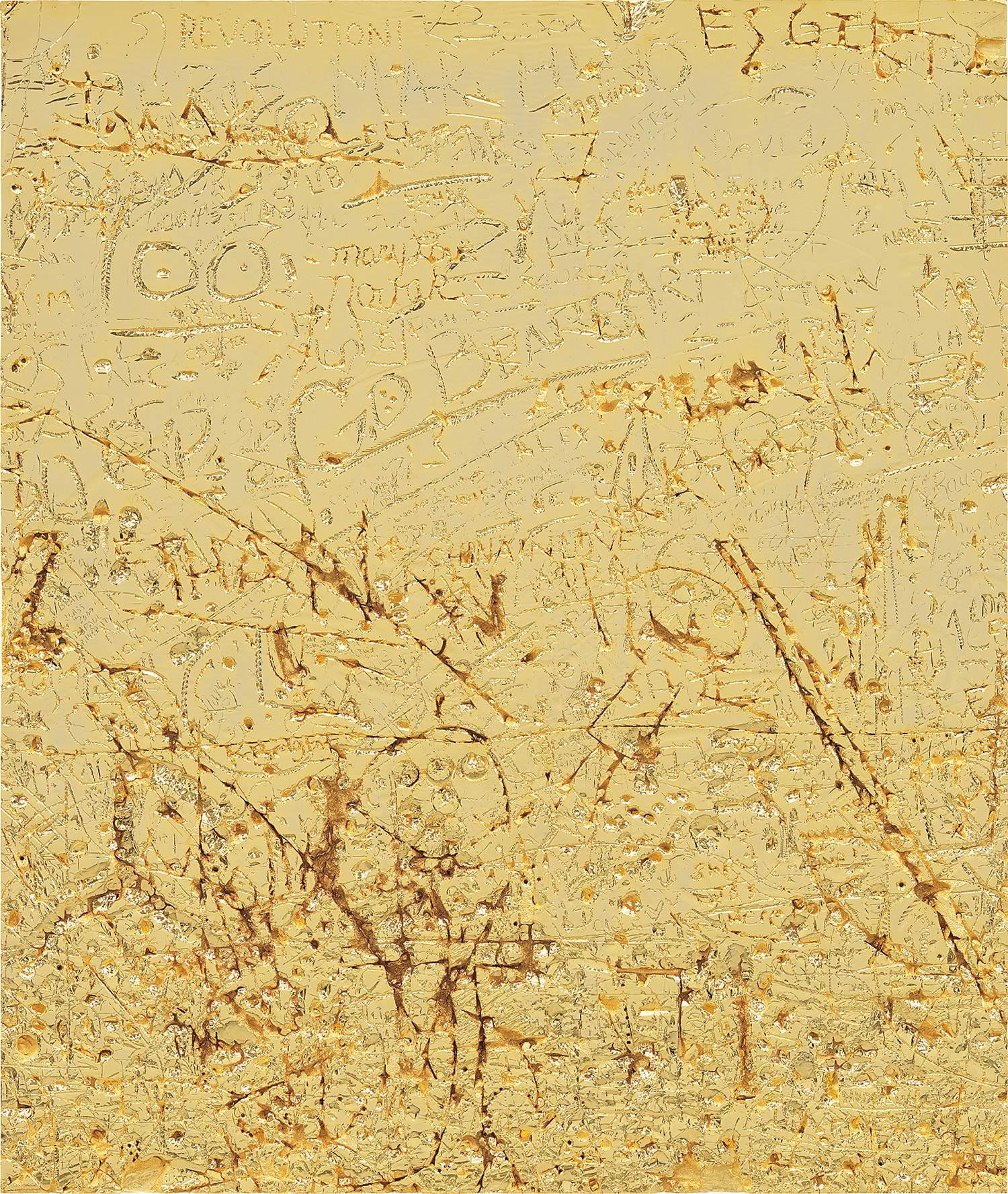

15Ο◆
Rudolf Stingel
Untitled
Full-Cataloguing
Though Untitled belongs to a set of moments in time – first, to its hanging as an immaculate support in early days at the Museum of Contemporary Art in Chicago and the Whitney Museum of American Art in New York, then to its progressive transformation into an arena for scripture, and finally, to its polished appearance extracted and isolated in 2012. The visual codes and concepts it employs quote a history of mark-making that spans Egyptian hieroglyphic scripture, Cy Twombly’s poetic frenetic lines atop blackboards or canvases, and Jean-Michel Basquiat’s graffiti in the urban environment of downtown New York. In addition to coalescing symbols of the past and the present, Stingel here blurs the boundaries between painting, sculpture, and performance, astutely combining the three across the single surface of the present work. ‘The performative nature of Stingel’s mark-making makes evident its three-dimensional presence as a symbol of painting, rather than as painting itself’, mused Chrissie Iles. ‘The pristine smoothness of its sumptuous surface has been destroyed, just as the purity of modernist abstract painting was destroyed in the 1960s’ (Chrissie Iles, ‘Surface Tension’, Rudolf Stingel, exh. cat., Museum of Contemporary Art, Chicago, 2007, p. 24).
The apotheosis of Stingel’s radically conceptual gesture, Untitled represents the culmination of the series of Celotex installations that he initiated in his solo exhibition at the Museo di Arte Moderna e Contemporanea in Trento, Italy, in 2001. For this exhibition, Stingel had covered the floor, walls, and ceiling of the gallery space with metallic insulation panels, together conjuring an aesthetic akin to Versailles’ hall of mirrors. The immaculate appearance of this installation did not last long, as the malleable surface of the floor gradually eroded under the visitors’ footsteps, and likely empowered some to impulsively target the walls with their inscriptions. As Stingel explained, ‘I hadn’t planned on this reaction. This abstract shell appeared to be perfect in a provocative way and apparently invited [each individual] to manifest [his impulse]. Numerous motives appear to have led to this behavior; the neutrality of the installation paired with the anonymity of the visitors certainly plays a role. I wouldn’t know where to say intervention stops and destruction begins’ (Rudolf Stingel, quoted in Reiner Zettl, ‘The Trickster’, Rudolf Stingel, exh. cat., Museum of Contemporary Art, Chicago, 2007, p. 35).
Process has always been at the heart of Stingel’s artistic investigation. In 1989, he published a manual aptly titled Instructions, that echoed Albrecht Dürer’s Painter’s Manual of the 16th century. The publication was designed to direct artists towards a clear and essential way of making step-by-step, and was immediately followed by a set of Instruction paintings that he created for a duration of eight years. Borne from serendipitous actions and gestures, Untitled eschews any particular instructions, bar the collation of an inviting, immaculate surface to a wall. It nonetheless perfectly encapsulates Stingel’s never-ending exploration of the limits of painting, engaging with external participation and issues of originality and authorship, in ways akin to Joseph Beuys’ participatory happenings, toying with the boundaries of artistic genres and categories.
The scintillating gold dominating the surface of Untitled elevates the collection of surface-marks pervading the work to a sublime structure, both beautiful and profound. Evocative of vandalism and graffiti, these traces are crystallised into small, gem-like inscriptions thanks to the painting’s electroformed copper and golden support. They are a testament to Stingel’s prodigious appropriative gesture, physically held in tension between painting, performance and sculpture.
Rudolf Stingel
Italian | 1956Rudolf Stingel came to prominence in the late 1980s for his insistence on the conceptual act of painting in a context in which it had been famously declared dead. Despite the prevailing minimalist and conceptual narrative of the time, the Italian-born artist sought to confront the fundamental aspirations and failures of Modernist painting through the very medium of painting itself. While his works do not always conform to the traditional definitions of painting, their attention to surface, space, color and image provide new and expanded ways of thinking about the process and "idea" of painting. Central to his multifarious and prolific oeuvre is an examination of the passage of time and the probing of the fundamental questions of authenticity, meaning, hierarchy, authorship and context by dislocating painting both internally and in time and space. Stingel is best known for his wall-to-wall installations, constructed of fabric or malleable Celotex sheets, as well as his seemingly more traditional oil-on-canvas paintings.